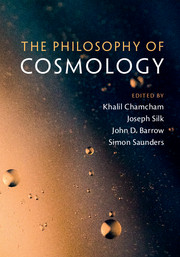Book contents
- Frontmatter
- Contents
- List of Contributors
- Preface
- Acknowledgments
- Part I Issues in the Philosophy of Cosmology
- Part II Structures in the Universe and the Structure of Modern Cosmology
- 5 Some Generalities About Generality
- 6 Emergent Structures of Effective Field Theories
- 7 Cosmological Structure Formation
- 8 Formation of Galaxies
- Part III Foundations of Cosmology: Gravity and the Quantum
- Part IV Quantum Foundations and Quantum Gravity
- Part V Methodological and Philosophical Issues
- Index
- References
8 - Formation of Galaxies
from Part II - Structures in the Universe and the Structure of Modern Cosmology
Published online by Cambridge University Press: 18 April 2017
- Frontmatter
- Contents
- List of Contributors
- Preface
- Acknowledgments
- Part I Issues in the Philosophy of Cosmology
- Part II Structures in the Universe and the Structure of Modern Cosmology
- 5 Some Generalities About Generality
- 6 Emergent Structures of Effective Field Theories
- 7 Cosmological Structure Formation
- 8 Formation of Galaxies
- Part III Foundations of Cosmology: Gravity and the Quantum
- Part IV Quantum Foundations and Quantum Gravity
- Part V Methodological and Philosophical Issues
- Index
- References
Summary
Introduction
Galaxies are key elements of the universe. They probe cosmology, they control our existence. The broad lines of their formation and evolution are clear. Beginning as infinitesimal density fluctuations, in the early universe, leaving the observed relic pattern of temperature fluctuations on the last scattering surface of the CMB, galaxy halos grew via gravitational instability of cold weakly interacting dark matter, within which baryons dissipated and cooled into the observed galaxies. We are piecing together the missing steps, that involve assembly of massive halos from a hierarchy of merging subhalos.Memory remains in massive halos of the substructure forged by gravity: this has been one of the major revelations to come from computer simulations of structure formation in the expanding universe.
A major advance in demonstrating that galaxies formed via gravitational instability in the early universe came with the discovery of fine-scale angular fluctuations in the CMB. These were predicted as essential relics if galaxies had indeed formed by the conjectured instability. Prior to their discovery, one had no idea of the initial conditions for seeding structure formation. Thermal fluctuations in standard cosmology were known to be too small.
Observations provided the seeds. The breakthrough came with the COBE satellite in 1990. This provided the proof that temperature fluctuations are present and monitor the existence of large-scale density fluctuations. These had little to do, however, with the search for the precursors of galaxies, other than giving confidence that the latter are present under the assumption of a scale-invariant density fluctuation spectrum as advocated by inflationary cosmology.
The key theoretical insight indeed preceded the data. Inflationary cosmology was developed in the 1980s, and provided for the first time a coherent understanding of the size of the universe, its near-Euclidean geometry, and of the origin of the seed density fluctuations from quantum fluctuations at the Planck epoch. Even inflationary cosmology remains incomplete, since there is still no theory of quantum gravity required in order to connect Planck-scale physics rigorously with the Einstein–Friedmann–Lemaˆıtre cosmology that successfully describes the evolution of the universe. Such a connection is essential in order to understand the nature of the acceleration that couples inflation to the current acceleration of the universe, with an associated decrease in vacuum energy of some 120 orders of magnitude.
- Type
- Chapter
- Information
- The Philosophy of Cosmology , pp. 161 - 178Publisher: Cambridge University PressPrint publication year: 2017



